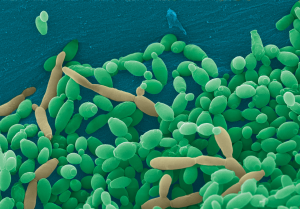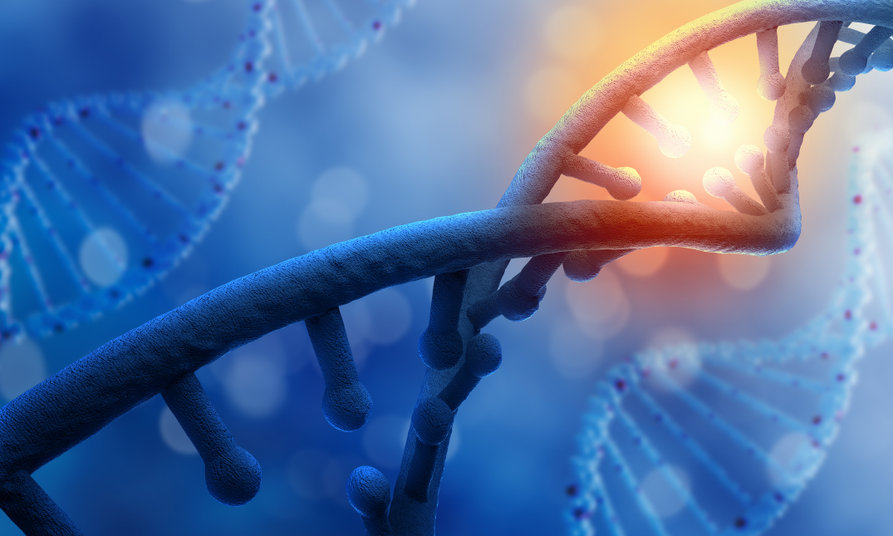 It’s hard to live in a living world without some living organisms taking residence on or inside of your body. It might not be the most pleasant idea, but everyone is carrying bugs of some sort. Harmful organisms in the intestines and bacteria in the gut are among the most common. Another is Candida albicans. If you’ve ever experienced a yeast infection, then you probably know this one well . Although everyone has Candida, problems are unlikely to arise if it’s kept in balance. However, if Candida imbalance occurs, so may a yeast infection. Yeast infections can affect the mouth, skin and genitals (and that includes women AND men) and range in severity from inconvenient and uncomfortable to life-threatening. Additionally, overgrowth in the gastrointestinal tract may be a catalyst for serious problems if the fungus enters the bloodstream.
It’s hard to live in a living world without some living organisms taking residence on or inside of your body. It might not be the most pleasant idea, but everyone is carrying bugs of some sort. Harmful organisms in the intestines and bacteria in the gut are among the most common. Another is Candida albicans. If you’ve ever experienced a yeast infection, then you probably know this one well . Although everyone has Candida, problems are unlikely to arise if it’s kept in balance. However, if Candida imbalance occurs, so may a yeast infection. Yeast infections can affect the mouth, skin and genitals (and that includes women AND men) and range in severity from inconvenient and uncomfortable to life-threatening. Additionally, overgrowth in the gastrointestinal tract may be a catalyst for serious problems if the fungus enters the bloodstream.
Let’s take a look at a few other must-know facts about yeast infections.
1. Yeast Infections May Occur Orally
Gross. Really? Yes, oral yeast infections are commonly called thrush. This infection is common in newborns but typically passes quickly. Babies are not the only ones affected, a recent study found that oral Candida overgrowth occurs in one out of every four adults. Poor oral hygiene is often a primary factor. Researchers identified the presence of plaque, tartar, and amalgam fillings as significantly related to the degree of Candida present. [1] The best defense? Proper, and regular, oral hygiene.
2. Vaginal Yeast Infections Can Be Tricky
Practicing good hygiene is a very good deterrent for yeast infections. However, this isn’t always the case. Frequent douching has been associated with higher incidences of yeast infections. So has wearing tight nylon or synthetic underwear. Oddly enough, over-the-counter anti-fungal medications have also been associated with stubborn occurrences of vaginal candiadosis. [2] The use of intrauterine contraceptive devices also show a statistically significant increase in Candida infection. [3]
3. Use of an Asthma Inhaler May Contribute to Candida
A Brazilian study of adults using inhalers for longer than 6 months identified oral candidiasis as one of several adverse effects. [4] Anyone using an inhaler, or any other oral appliance (such as mouth guards, retainers, or dentures) should be aware of the possibility of Candida exposure.
4. Candida Naturally Occurs On and In Humans
Microbiota like Candida occur naturally on human skin and in the human gastrointestinal tract. In healthy individuals, the immune system and symbiotic bacteria help keep these fungal species in check. Not surprisingly, persons with compromised immune systems are among the most susceptible to Candida overgrowth.
5. The Connection Between Diabetes and Candida
Individuals with diabetes are more likely to develop genital yeast infections, both women and men. The high blood glucose levels of diabetics encourage yeast growth. And, because it inhibits immune response, the risk of recurring infection is higher. Women are more likely to suffer infection from Candida alibicans and Candida glabrate. Uncircumsized men may experience infection from Candida balaritis. [5]
6. Candida Often Accompanies HIV
Research has shown nearly 90% of HIV positive patients suffer from oral Candiadisis. In contrast, these patients do not experience an increase in genital yeast infection. [6]
7. Candida Loves Carbohydrates
While Candida occurs naturally in the human digestive tract, how much is present depends quite a bit on diet. Studies have identified that persons whose diets are high in carbohydrates are more susceptible than persons whose diets are high in amino acids, proteins and fatty acids. Candida levels increase most immediately following consumption of carbohydrates.[7]
8. You Can Protect Yourself With Probiotics
Intestinal yeast infections, or Candida overgrowth, have been associated with the development of several Irritable Bowel Diseases (IBDs) such as Crohn’s disease. Protecting intestinal health has become a major focus for research. One study identified a probiotic strain as successful for improving cellular defense against Candida. [8]
9. Presents an Increased Risk of MS
This one is an unforeseen doozy to most — Candida infection has been associated with increased odds of multiple sclerosis (MS). A case-control study evaluated the relationship of MS and Candida infection and discovered that MS patients showed higher overall blood serum levels of Candida than the control group. [9]
10. Potential Remedy for Warts?
Perhaps not all facts about Candida infections are bad. One study found positive benefits from using a purified C. albicans antigen solution for persistent warts. This has led researchers to suggest intralesional Candida immunotherapy may provide an effective treatment for warts resistant to other forms of destruction. [10]
Contact Natural Medicine Center of Lakeland if you are suffering from Candida Overgrowth
References:
- Muzurovic S, Babajic E, Masic T, Smajic R, Selmanagic A. The relationship between oral hygiene and oral colonisation with Candida species. Med Arh. 2012;66(6):415-7.
- Ekpenyong CE, Inyang-etoh EC, Ettebong EO, Akpan UP, Ibu JO, Daniel NE.Recurrent vulvovaginal candidosis among young women in south eastern Nigeria: the role of lifestyle and health-care practices. Int J STD AIDS. 2012 Oct;23(10):704-9. doi: 10.1258/ijsa.2012.011382.
- Güdücü N, Gönenç G, Içi H, Yi?iter AB, Basüllü N, Dünder I. Clinical importance of detection of bacterial vaginosis, trichomonas vaginalis, candida albicans and actinomyces in Papanicolaou smears. Clin Exp Obstet Gynecol. 2012;39(3):333-6.
- Pinto CR, Almeida NR, Marques TS, Yamamura LL, Costa LA, Souza-Machado A. Local adverse effects associated with the use of inhaled corticosteroids in patients with moderate or severe asthma. J Bras Pneumol. 2013 Jun-Aug;39(4):409-17. doi: 10.1590/S1806-37132013000400003.
- PNyirjesy P, Sobel JD. Genital mycotic infections in patients with diabetes. Postgrad Med. 2013 May;125(3):33-46. doi: 10.3810/pgm.2013.05.2650.
- Fidel PL Jr. Immunity to Candida. Oral Dis. 2002;8 Suppl 2:69-75.
- Hoffmann C, Dollive S, Grunberg S, Chen J, Li H, Wu GD, Lewis JD, Bushman FD. Archaea and fungi of the human gut microbiome: correlations with diet and bacterial residents. PLoS One. 2013 Jun 17;8(6):e66019. doi: 10.1371/journal.pone.0066019. Print 2013.
- Rizzo A, Losacco A, Carratelli CR. Lactobacillus crispatus modulates epithelial cell defense against Candida albicans through Toll-like receptors 2 and 4, interleukin 8 and human β-defensins 2 and 3. Immunol Lett. 2013 Oct 10. pii: S0165-2478(13)00158-2. doi: 10.1016/j.imlet.2013.08.013.
- Benito-León J, Pisa D, Alonso R, Calleja P, Díaz-Sánchez M, Carrasco L. Association between multiple sclerosis and Candida species: evidence from a case-control study. Eur J Clin Microbiol Infect Dis. 2010 Sep;29(9):1139-45. doi: 10.1007/s10096-010-0979-y. Epub 2010 Jun 17.
- Majid I, Imran S. Immunotherapy with Intralesional Candida Albicans Antigen in Resistant or Recurrent Warts: A Study. Indian J Dermatol. 2013 Sep;58(5):360-365.






